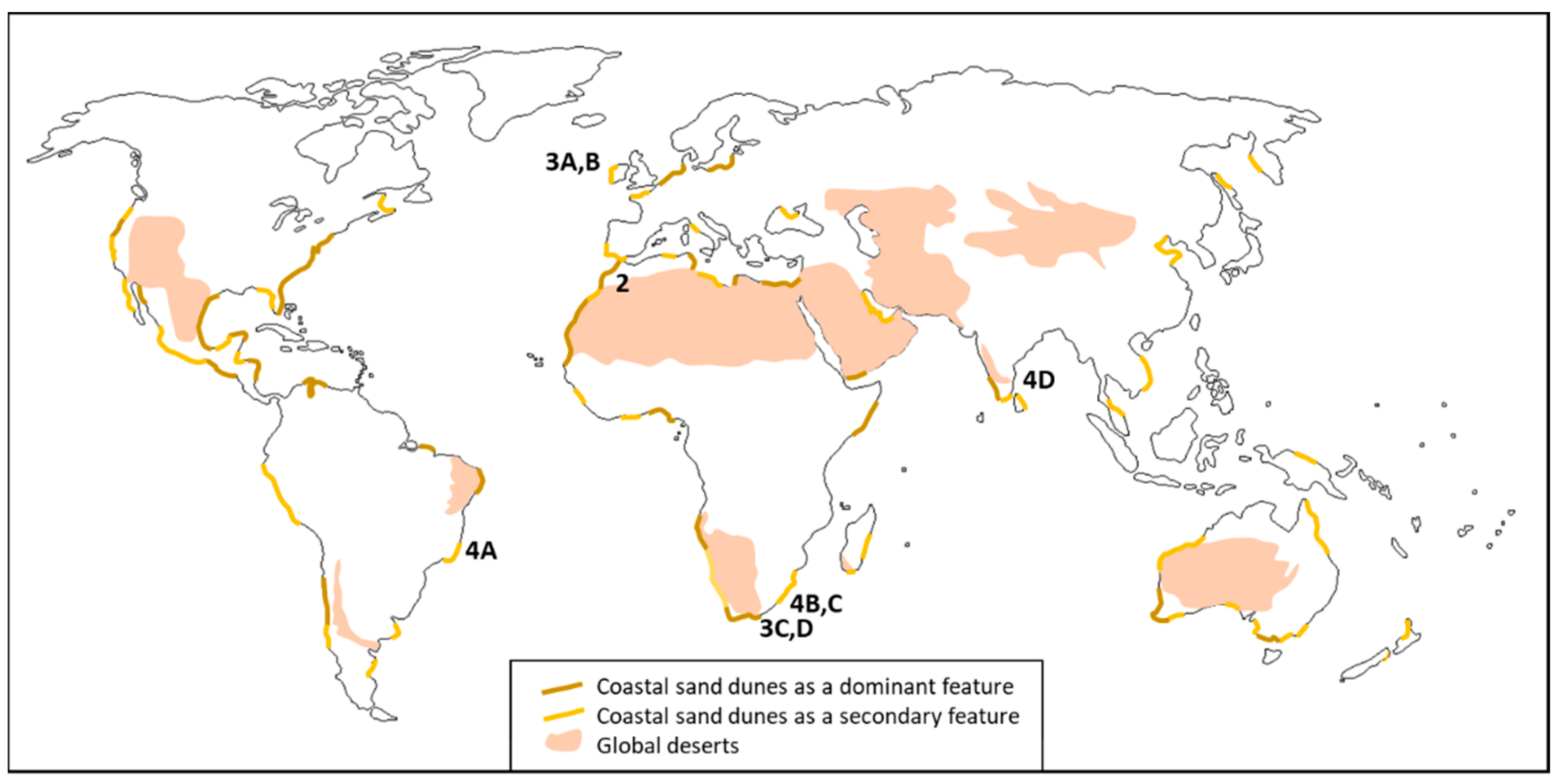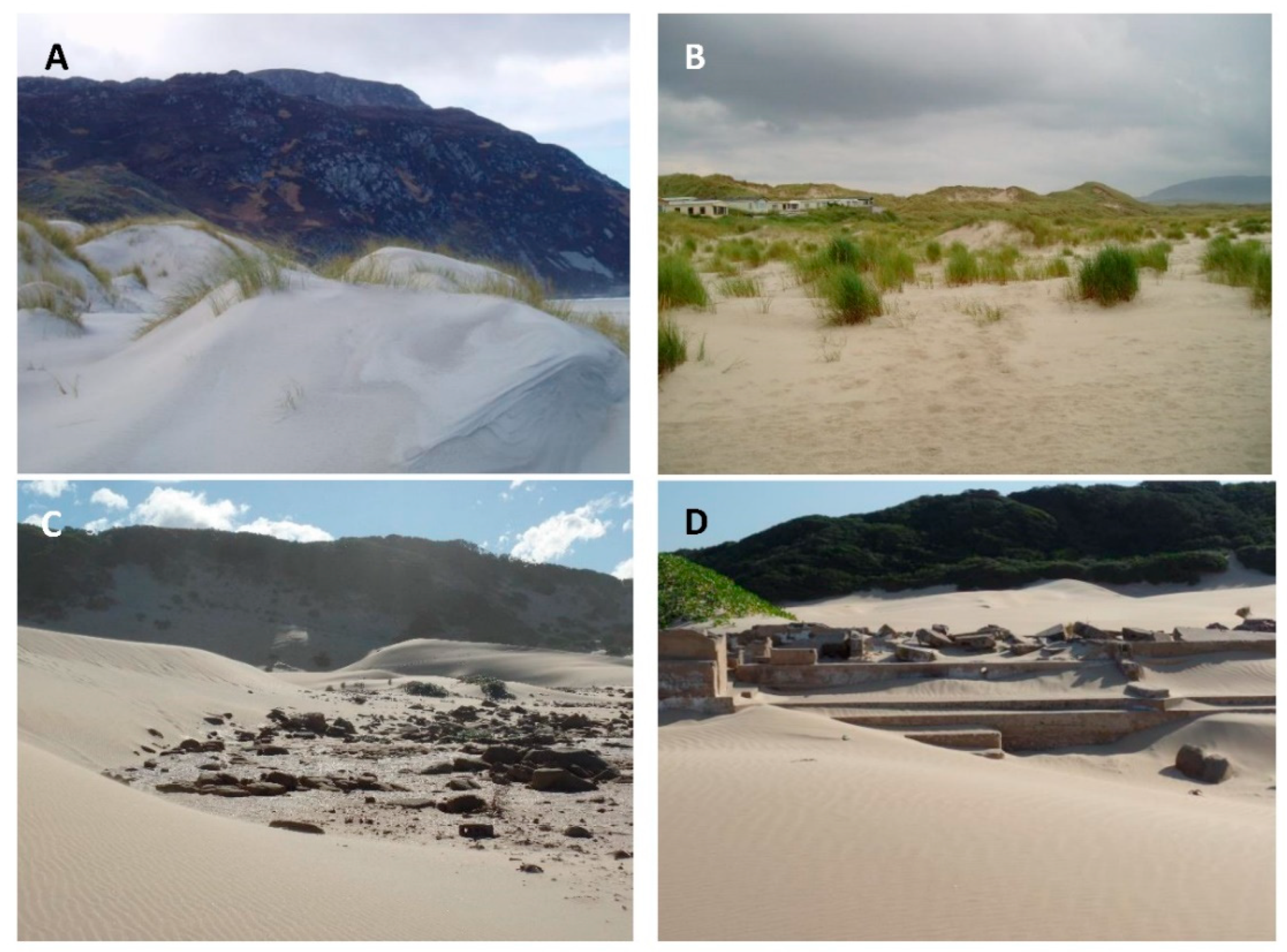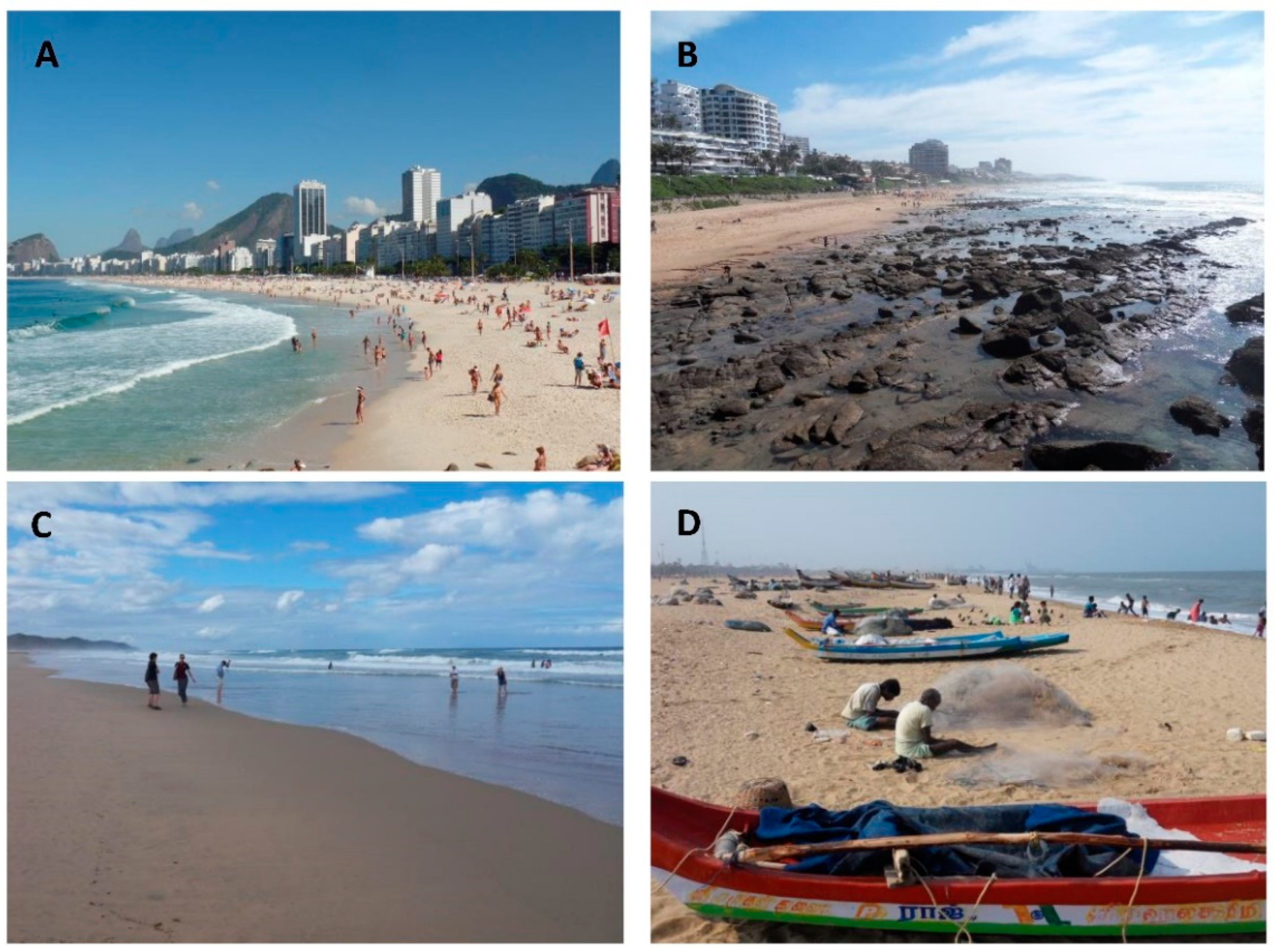Presence, Absence, Transience: The Spatiotemporalities of Sand
Abstract
1. Introduction
2. Sand in the Earth System
3. Making Sense of Sand: Presence, Absence, Transience
3.1. Presence and Absence
3.2. Transience
4. The Meaning and Interpretation of Sand: Examples from Different Contexts
4.1. Desert Sand Dunes
4.2. Sandy Beaches
5. Discussion
5.1. Interpreting Sand through a Human Lens
5.2. The Life-Ways of Sand
5.3. Landscape Change in the Anthropocene
6. Conclusions
Funding
Data Availability Statement
Acknowledgments
Conflicts of Interest
References
- Ingold, T. The temporality of the landscape. World Archaeol. 1993, 25, 152–174. [Google Scholar] [CrossRef]
- Lazarus, E.D.; Ellis, M.A.; Murray, A.B.; Hall, D.M. An evolving research agenda for human–coastal systems. Geomorphology 2016, 256, 81–90. [Google Scholar] [CrossRef]
- Beiser, V. The World in a Grain: The Story of Sand and How It Transformed Civilization; Riverhead Books: New York, NY, USA, 2018. [Google Scholar]
- Appleton, J. The Experience of Landscape; Wiley: London, UK, 1996. [Google Scholar]
- Selman, P.; Swanwick, C. On the meaning of natural beauty in landscape legislation. Landsc. Res. 2010, 35, 3–26. [Google Scholar] [CrossRef]
- Huber, M. Resource geographies I: Valuing nature (or not). Progr. Human Geogr. 2018, 42, 148–159. [Google Scholar] [CrossRef]
- Bendiner-Viani, G. The big world in the small: Layered dynamics of meaning-making in the everyday. Env. Plann. D Soc. Space 2013, 31, 708–726. [Google Scholar] [CrossRef]
- Beery, T.; Jönsson, K.I.; Elmberg, J. From Environmental Connectedness to Sustainable Futures: Topophilia and Human Affiliation with Nature. Sustainability 2015, 7, 8837–8854. [Google Scholar] [CrossRef]
- Lowenthal, D. Geography, experience, and imagination: Towards a geographical epistemology. Ann. Am. Assoc. Geogr. 1961, 51, 241–260. [Google Scholar] [CrossRef]
- Olwig, K. Landscape: The Lowenthal Legacy. Ann. Am. Assoc. Geogr. 2003, 93, 871–877. [Google Scholar] [CrossRef]
- Brambilla, C. Exploring the critical potential of the borderscapes concept. Geopolitics 2015, 20, 14–34. [Google Scholar] [CrossRef]
- Kothari, U.; Arnall, A. Shifting sands: The rhythms and temporalities of island sandscapes. Geoforum 2020, 108, 305–314. [Google Scholar] [CrossRef]
- Tudor, D.T.; Williams, A.T. A rationale for beach selection by the public on the coast of Wales, UK. Area 2006, 38, 153–164. [Google Scholar] [CrossRef]
- Pearson, T.W. Frac sand mining and the disruption of place, landscape, and community in Wisconsin. Hum. Organiz. 2016, 75, 47–58. [Google Scholar] [CrossRef]
- Baldacchino, G. Re-Placing Materiality. A Western Anthropology of Sand. Ann. Tour. Res. 2010, 37, 763–778. [Google Scholar] [CrossRef]
- Williams, A.T. Some scenic evaluation techniques. In Coastal Scenery; Rangel-Buitrago, N., Ed.; Springer: Berlin, Germany, 2019; pp. 43–65. [Google Scholar]
- McKinley, E.; Pagès, J.F.; Ballinger, R.C.; Beaumont, N. Forgotten landscapes: Public attitudes and perceptions of coastal saltmarshes. Oc. Coast. Manag. 2020, 187, 105117. [Google Scholar] [CrossRef]
- Trimbach, D.J.; Biedenweg, K. Shared shorelines, shared meanings?: Examining place meaning in Puget Sound. Appl. Geogr. 2021, 135, 102559. [Google Scholar] [CrossRef]
- Walton, R.T.; Shaw, W.S. Childhood hazard encounters at Australian beaches and their influence on attachment behaviours in adulthood. Area 2021, 53, 326–335. [Google Scholar] [CrossRef]
- Obrador-Pons, P. Building castles in the sand: Repositioning touch on the beach. Senses Soc. 2009, 4, 195–210. [Google Scholar] [CrossRef]
- Zee, J.C. Holding patterns: Sand and political time at China’s desert shores. Cult. Anthropol. 2017, 32, 215–241. [Google Scholar] [CrossRef]
- Matless, D. Next the Sea: Eccles and the Anthroposcenic. J. Hist. Geogr. 2018, 62, 71–84. [Google Scholar] [CrossRef]
- Dutkiewicz, A.; Müller, R.D.; O’Callaghan, S.; Jónasson, H. Census of seafloor sediments in the world’s ocean. Geology 2015, 43, 795–798. [Google Scholar] [CrossRef]
- Straume, E.O.; Gaina, C.; Medvedev, S.; Hochmuth, K.; Gohl, K.; Whittaker, J.M.; Abdul Fattah, R.; Doornenbal, J.C.; Hopper, J.R. GlobSed: Updated total sediment thickness in the world’s oceans. Geochem. Geophys. Geosyst. 2019, 20, 1756–1772. [Google Scholar] [CrossRef]
- Wentworth, C.K. A scale of grade and class terms for clastic sediments. J. Geol. 1922, 30, 377–392. [Google Scholar] [CrossRef]
- Krulwich, K. Which Is Greater, the Number of Sand Grains on Earth or Stars in the Sky? Krulwich Wonders, npr. Available online: https://www.npr.org/sections/krulwich/2012/09/17/161096233/which-is-greater-the-number-of-sand-grains-on-earth-or-stars-in-the-sky (accessed on 17 September 2012).
- Welland, M. Sand: The Never-Ending Story; University of California Press: Berkeley, CA, USA, 2009. [Google Scholar]
- Kelletat, D.H. Atlas of Coastal Geomorphology and Zonality; Coastal Education & Research Foundation: Lawrence, KS, USA, 1995. [Google Scholar]
- Laity, J. Deserts and Desert Environments; Wiley-Blackwell: Chichester, UK, 2008. [Google Scholar]
- Mazzullo, J.; Magenheimer, S. The original shapes of quartz sand grains. J. Sediment. Petrol. 1987, 57, 479–487. [Google Scholar] [CrossRef]
- Newsome, D.; Ladd, P. The use of quartz grain microtextures in the study of the origin of sand terrains in Western Australia. Catena 1999, 35, 1–17. [Google Scholar] [CrossRef]
- Kasper-Zubillaga, J.J.; Dickinson, W.W.; Carranza-Edwards, A.; Hornelas-Orozco, Y. Petrography of quartz grains in beach and dune sands of Northland, North Island, New Zealand. N. Z. J. Geol. Geophys. 2005, 48, 649–660. [Google Scholar] [CrossRef]
- Massey, D. For Space; Sage: London, UK, 2005. [Google Scholar]
- Maddrell, A. Living with the deceased: Absence, presence and absence-presence. Cult. Geogr. 2013, 20, 501–522. [Google Scholar] [CrossRef]
- Lamb, V.; Marschke, M.; Rigg, J. Trading sand, undermining lives: Omitted livelihoods in the global trade in sand. Ann. Am. Assoc. Geogr. 2019, 109, 1511–1528. [Google Scholar] [CrossRef]
- Anderson, E.; Maddrell, A.; McLoughlin, K.; Vincent, A.M. (Eds.) Memory, Mourning, Landscape—At the Interface/Probing the Boundaries; Brill: The Hague, The Netherlands, 2010. [Google Scholar]
- Moshenska, G. Curated ruins and the endurance of conflict heritage. Conserv. Manag. Archaeol. Sites 2015, 17, 77–90. [Google Scholar] [CrossRef]
- Esterhuysen, A.; Knight, J.; Keartland, T. Mine waste: The unseen dead in a mining landscape. Progr. Phys. Geogr. 2018, 42, 650–666. [Google Scholar] [CrossRef]
- Jones, O. “Not Promising a Landfall …”: An Autotopographical Account of Loss of Place, Memory and Landscape. Env. Human. 2015, 6, 1–27. [Google Scholar] [CrossRef]
- Emery, J. Belonging, memory and history in the north Nottinghamshire coalfield. J. Hist. Geogr. 2018, 59, 77–89. [Google Scholar] [CrossRef]
- Storm, A.; Olsson, K. The pit: Landscape scars as potential cultural tools. Int. J. Herit. Stud. 2013, 19, 692–708. [Google Scholar] [CrossRef]
- Till, K.E.; Kuusisto-Arponen, A.-K. Towards responsible geographies of memory: Complexities of place and the ethics of remembering. Erdkunde 2015, 69, 291–306. [Google Scholar] [CrossRef]
- Jones, O.; Fairclough, L. Sounding grief: The Severn Estuary as an emotional soundscape. Emot. Space Soc. 2016, 20, 98–110. [Google Scholar] [CrossRef]
- Nieuwenhuis, M. The emergence of materialism in geography: Belonging and being, space and place, sea and land. Soc. Sci. Inf. 2016, 55, 300–320. [Google Scholar] [CrossRef]
- Bristow, C.S.; Chroston, P.N.; Bailey, S.D. The structure and development of foredunes on a locally prograding coast: Insights from ground-penetrating radar surveys, Norfolk, UK. Sedimentology 2000, 47, 923–944. [Google Scholar] [CrossRef]
- Harrison, S.; Dunham, P. Decoherence, quantum theory and their implications for the philosophy of geomorphology. Trans. Inst. Brit. Geogr. 1998, 23, 501–514. [Google Scholar] [CrossRef]
- Nieuwenhuis, M.; Nassar, A. Dust: Perfect circularity. Cult. Geogr. 2018, 25, 501–507. [Google Scholar] [CrossRef]
- Knight, J.; Harrison, S. Transience in cascading paraglacial systems. Land Degrad. Develop. 2018, 29, 1991–2001. [Google Scholar] [CrossRef]
- Mudd, S.M. Detection of transience in eroding landscapes. Earth Surf. Proc. Landf. 2017, 42, 24–41. [Google Scholar] [CrossRef]
- Knight, J.; Zerboni, A. Formation of desert pavements and the interpretation of lithic-strewn landscapes of the central Sahara. J. Arid Env. 2018, 153, 39–51. [Google Scholar] [CrossRef]
- Hoffmann, T. Sediment residence time and connectivity in non-equilibrium and transient geomorphic systems. Earth-Sci. Rev. 2015, 150, 609–627. [Google Scholar] [CrossRef]
- Cendrero, A.; Remondo, J.; Beylich, A.; Cienciala, P.; Forte, L.; Golosov, V.; Gusarov, A.; Kijowska-Strugała, M.; Laute, K.; Li, D.; et al. Denudation and geomorphic change in the Anthropocene; a global overview. Earth-Sci. Rev. 2022, 233, 104186. [Google Scholar] [CrossRef]
- Okin, G.S.; D’Odorico, P.; Archer, S.R. Impact of feedbacks on Chihuahuan desert grasslands: Transience and metastability. J. Geophys. Res. 2009, 114, G01004. [Google Scholar] [CrossRef]
- Aguilar, G.; Riquelme, R.; Martinod, J.; Darrozes, J.; Maire, E. Variability in erosion rates related to the state of landscape transience in the semi-arid Chilean Andes. Earth Surf. Proc. Landf. 2011, 36, 1736–1748. [Google Scholar] [CrossRef]
- Knight, J.; Stratford, D. Investigating lithic scatters in arid environments: The Early and Middle Stone Age in Namibia. Proc. Geol. Assoc. 2020, 131, 778–783. [Google Scholar] [CrossRef]
- DeSilvey, C. Making sense of transience: An anticipatory history. Cult. Geogr. 2012, 19, 31–54. [Google Scholar] [CrossRef]
- Landzelius, M. Commemorative dis(re)membering: Erasing heritage, spatializing disinheritance. Env. Plan. D Soc. Space 2003, 21, 195–221. [Google Scholar] [CrossRef]
- DeSilvey, C. Observed decay: Telling stories with mutable things. J. Material Cult. 2006, 11, 318–338. [Google Scholar] [CrossRef]
- Wylie, J. Landscape, absence and the geographies of love. Trans. Inst. Brit. Geogr. NS 2009, 34, 275–289. [Google Scholar] [CrossRef]
- Perry, G.L.W. Landscapes, space and equilibrium: Shifting viewpoints. Progr. Phys. Geogr. 2002, 26, 339–359. [Google Scholar] [CrossRef]
- Ballantine, J.-A.C.; Okin, G.S.; Prentiss, D.E.; Roberts, D.A. Mapping North African landforms using continental scale unmixing of MODIS imagery. Remote Sens. Env. 2005, 97, 470–483. [Google Scholar] [CrossRef]
- Telbisz, T.; Keszler, O. DEM-based morphometry of large-scale sand dune patterns in the Grand Erg Oriental (Northern Sahara Desert, Africa). Arab. J. Geosci. 2018, 11, 382. [Google Scholar] [CrossRef]
- Bubenzer, O.; Embabi, N.S.; Ashour, M.M. Sand Seas and Dune Fields of Egypt. Geosciences 2020, 10, 101. [Google Scholar] [CrossRef]
- Dabboor, M.D.; Braun, A.; Kneen, M.A. Tracking sand dune migration in the Rub Al-Khali with ICESat laser altimetry. Int. J. Remote Sens. 2013, 34, 3832–3847. [Google Scholar] [CrossRef]
- Abdel Maksoud, K.M.; Al-Metwaly, W.M.; Ruban, D.A.; Yashalova, N.N. Sand dune migration as a factor of geoheritage loss: Evidence from the Siwa Oasis (Egypt) and implications for geoheritage management. Proc. Geol. Assoc. 2019, 130, 599–608. [Google Scholar] [CrossRef]
- Haynes, R.D. Desert: Nature and Culture; Reaktion Books: Chicago, IL, USA, 2014. [Google Scholar]
- Lecocq, B. Distant shores: A historiographic view on trans-Saharan space. J. Afr. Hist. 2015, 56, 23–36. [Google Scholar] [CrossRef]
- Forsyth, I. Designs on the desert: Camouflage, deception and the militarization of space. Cult. Geogr. 2014, 21, 247–265. [Google Scholar] [CrossRef]
- Thesiger, W. Across the Empty Quarter. Geogr. J. 1948, 111, 1–19. [Google Scholar] [CrossRef]
- Hunt, M.L.; Vriend, N.M. Booming Sand Dunes. Ann. Rev. Earth Planet. Sci. 2010, 38, 281–301. [Google Scholar] [CrossRef]
- Curzon, Marquess of Kedleston. Tales of Travel; Hodder and Stoughton: London, UK, 1923. [Google Scholar]
- Cooper, D. How to draw a dust storm. J. Landsc. Archit. 2019, 14, 36–41. [Google Scholar] [CrossRef]
- Wasserstein, D.J. Bad Weather in Baghdad: Al-Ṭurṭūshī and the “Eclipse” of 478/1085–1086. Al-Qantara 2019, 60, 219–236. [Google Scholar] [CrossRef]
- Anthony, E.J.; Vanhée, S.; Ruz, M.-H. Embryo dune development on a large, actively accreting macrotidal beach: Calais, North Sea coast of France. Earth Surf. Proc. Landf. 2007, 32, 631–636. [Google Scholar] [CrossRef]
- Gao, J.; Kennedy, D.M.; Konlechner, T.M. Coastal dune mobility over the past century: A global review. Prog. Phys. Geogr. 2020, 44, 814–836. [Google Scholar] [CrossRef]
- Botero, C.; Pereira, C.; Anfuso, A.; Cervantes, O.; Williams, A.T.; Pranzini, E.; Silva, C.P. Recreational parameters as an assessment tool for beach. J. Coastal Res. 2014, SI70, 556–562. [Google Scholar] [CrossRef]
- Cabezas-Rabadán, C.; Rodilla, M.; Pardo-Pascual, J.E.; Herrera-Racionero, P. Assessing users’ expectations and perceptions on different beach types and the need for diverse management frameworks along the Western Mediterranean. Land Use Pol. 2019, 81, 219–231. [Google Scholar] [CrossRef]
- de Freitas, C.R. Weather and place-based human behavior: Recreational preferences and sensitivity. Int. J. Biometeorol. 2015, 59, 55–63. [Google Scholar] [CrossRef]
- Morris, B. In defence of oblivion: The case of Dunwich, Suffolk. Int. J. Herit. Stud. 2014, 20, 196–216. [Google Scholar] [CrossRef]
- Matless, D. The Anthroposcenic. Trans. Inst. Brit. Geogr. 2017, 42, 363–376. [Google Scholar] [CrossRef]
- Venture, T.; DeSilvey, C.; Onciul, B.; Fluck, H. Articulating Loss: A Thematic Framework for Understanding Coastal Heritage Transformations. Historic Env. Pol. Pract. 2021, 12, 395–417. [Google Scholar] [CrossRef]
- Toubes, D.R.; Araújo-Vila, N.; Fraiz-Brea, J.A. Influence of weather on the behaviour of tourists in a beach destination. Atmosphere 2020, 11, 121. [Google Scholar] [CrossRef]
- Preston-Whyte, R. Constructions of surfing space at Durban, South Africa. Tour. Geogr. 2002, 4, 307–328. [Google Scholar] [CrossRef]
- Castelle, B.; Turner, I.L.; Bertin, X.; Tomlinson, R. Beach nourishments at Coolangatta Bay over the period 1987–2005: Impacts and lessons. Coast. Eng. 2009, 56, 940–950. [Google Scholar] [CrossRef]
- Vikolainen, V.; Flikweert, J.; Bressers, H.; Lulofs, K. Governance context for coastal innovations in England: The case of sandscaping in North Norfolk. Oc. Coast. Manag. 2017, 145, 82–93. [Google Scholar] [CrossRef]
- de Ruyck, A.M.C.; Soares, A.G.; McLachlan, A. Social Carrying Capacity as a Management for Sandy Beaches. J. Coast. Res. 1997, 13, 822–830. [Google Scholar] [CrossRef]
- Thomas, M.; Roberts, E.; Pidgeon, N.; Henwood, K. ‘This funny place’: Uncovering the ambiguity of saltmarshes using a multimodal approach. People Nat. 2022, 4, 804–815. [Google Scholar] [CrossRef]
- DeSilvey, C. Salvage memory: Constellating material histories on a hardscrabble homestead. Cult. Geogr. 2007, 14, 401–424. [Google Scholar] [CrossRef]
- Hansen, Z.K.; Libecap, G.D. Small farms, externalities, and the Dust Bowl of the 1930s. J. Politic. Econ. 2004, 112, 665–694. [Google Scholar] [CrossRef]
- Cordova, C.; Porter, J.C. The 1930s Dust Bowl: Geoarchaeological lessons from a 20th century environmental crisis. Holocene 2015, 25, 1707–1720. [Google Scholar] [CrossRef]
- Uekötter, F. The Meaning of Moving Sand. Towards a Dust Bowl Mythology. Glob. Env. 2015, 8, 349–379. [Google Scholar] [CrossRef]
- Bridge, G. Contested terrain: Mining and the environment. Ann. Rev. Env. Res. 2004, 29, 205–259. [Google Scholar] [CrossRef]
- Lefebvre, H. Rhythmanalysis: Space, Time and Everyday Life; Elden, S., Translator; Continuum: London, UK, 2004. [Google Scholar]
- Reid-Musson, E. Intersectional rhythmanalysis: Power, rhythm, and everyday life. Progr. Hum. Geogr. 2018, 42, 881–897. [Google Scholar] [CrossRef]
- Flemsæter, F.; Gundersen, V.; Rønningen, K.; Strand, O. The beat of the mountain: A transdisciplinary rhythmanalysis of temporal landscapes. Landsc. Res. 2019, 44, 937–951. [Google Scholar] [CrossRef]
- Kothari, U.; Arnall, A. Everyday life and environmental change. Geogr. J. 2019, 185, 130–141. [Google Scholar] [CrossRef]
- Larsen, J. Running on sandcastles’: Energising the rhythmanalyst through non-representational ethnography of a running event. Mobilities 2019, 14, 561–577. [Google Scholar] [CrossRef]
- Holmberg, T. Walking, eating, sleeping. Rhythm analysis of human/dog intimacy. Emot. Space Soc. 2019, 31, 26–31. [Google Scholar] [CrossRef]
- Wilkinson, B.H. Humans as geologic agents: A deep-time perspective. Geology 2005, 33, 161–164. [Google Scholar] [CrossRef]
- Knight, J. Anthropocene Futures: People, landscapes and resources. Anthrop. Rev. 2015, 2, 152–158. [Google Scholar] [CrossRef]
- Goudie, A. The human impact in geomorphology—50 years of change. Geomorphology 2020, 366, 106601. [Google Scholar] [CrossRef]
- Bell, S.; Peña, A.C.; Prem, M. Imagine coastal sustainability. Oc. Coast. Manag. 2013, 83, 39–51. [Google Scholar] [CrossRef]
- Glavovic, B.C.; Limburg, K.; Liu, K.-K.; Emeis, K.-C.; Thomas, H.; Kremer, H.; Avril, B.; Zhang, J.; Mulholland, M.R.; Glaser, M.; et al. Living on the Margin in the Anthropocene: Engagement arenas for sustainability research and action at the ocean–land interface. Curr. Opin. Env. Sustain. 2015, 14, 232–238. [Google Scholar] [CrossRef]
- Parkkinen, M. Engagements with uncertain futures—Analysing survivalist preparedness. Futures 2021, 133, 102822. [Google Scholar] [CrossRef]
- Brooks, N.; Clarke, J.; Ngaruiya, G.W.; Wangui, E.E. African heritage in a changing climate. Azania 2020, 55, 297–328. [Google Scholar] [CrossRef]





Publisher’s Note: MDPI stays neutral with regard to jurisdictional claims in published maps and institutional affiliations. |
© 2022 by the author. Licensee MDPI, Basel, Switzerland. This article is an open access article distributed under the terms and conditions of the Creative Commons Attribution (CC BY) license (https://creativecommons.org/licenses/by/4.0/).
Share and Cite
Knight, J. Presence, Absence, Transience: The Spatiotemporalities of Sand. Geographies 2022, 2, 657-668. https://doi.org/10.3390/geographies2040040
Knight J. Presence, Absence, Transience: The Spatiotemporalities of Sand. Geographies. 2022; 2(4):657-668. https://doi.org/10.3390/geographies2040040
Chicago/Turabian StyleKnight, Jasper. 2022. "Presence, Absence, Transience: The Spatiotemporalities of Sand" Geographies 2, no. 4: 657-668. https://doi.org/10.3390/geographies2040040
APA StyleKnight, J. (2022). Presence, Absence, Transience: The Spatiotemporalities of Sand. Geographies, 2(4), 657-668. https://doi.org/10.3390/geographies2040040






